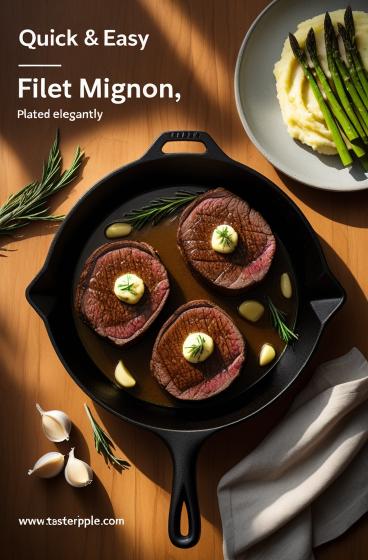There’s something about filet mignon that makes people pause.
Maybe it’s the buttery tenderness. Maybe it’s the way it slices like room-temp butter.
Or maybe it’s because for years, it’s been labeled a “special occasion steak.”
But let’s change that.
You don’t need white tablecloths or an overpriced wine list to enjoy a restaurant-worthy filet.
This version is quick, simple, and scandalously delicious — no grill, no sous-vide, no fuss.
We’re talking about a stovetop sear, a hot oven kiss, and a garlic herb butter bath that’ll make your kitchen smell like heaven’s steakhouse.
The whole thing? Done in under 30 minutes. Seriously.
Why This Filet Mignon Recipe Is So Special
Filet mignon is known for its tenderness, but it can fall flat in flavor if not treated right.
That’s where this recipe shines. We don’t just rely on salt and pepper — we build layers.
Searing in cast iron? That’s your crust.
Finishing in the oven? That’s your perfectly blushing center.
Garlic herb butter? That’s the magic.
And since it’s so fast — you can make it on a random Tuesday. Or date night. Or when you just feel like spoiling yourself.
No grill. No reverse sear. No panic about ruining an expensive cut.
This is filet mignon made foolproof.
Ingredients & Substitutions
You’ll only need a handful of ingredients — but the quality matters.
Here’s your cheat sheet:
| Ingredient | Details / Substitutions |
|---|---|
| Filet mignon steaks | 6–8 oz each, at least 1.5” thick; tenderloin medallions work |
| Kosher salt | Don’t skimp; coarse kosher gives the best flavor |
| Black pepper | Freshly cracked, lots of it for flavor and crust |
| High-heat oil | Avocado, grapeseed, or canola — anything neutral |
| Unsalted butter | For basting — salted works too, just reduce added salt |
| Garlic cloves | Smashed, not minced — for flavor without burning |
| Fresh rosemary | Or thyme — don’t use dried here |
| Optional: Shallots | Slice and toss in the pan for bonus steakhouse flair |
Pro tip:
Don’t cook filet mignon straight from the fridge. Let it sit at room temp for 30–40 minutes so it cooks evenly.
Step-by-Step Instructions
Let’s keep it foolproof and fast. This method gives you a stunning crust with a pink, juicy center.
1. Prep the steaks (10 minutes before cooking)
- Pat filets dry with paper towels — moisture is the enemy of a good sear.
- Season generously with kosher salt and cracked pepper. Go bold.
- Preheat oven to 425°F (220°C).
2. Sear the steaks (5–6 minutes total)
- Heat a heavy cast-iron skillet over medium-high until just shy of smoking.
- Add high-heat oil, swirl to coat.
- Place steaks in pan and do not touch for 2–3 minutes. That’s how the crust forms.
- Flip, and sear 2–3 minutes more.
You should see a deep brown crust and smell caramelized beef. That’s flavor locked in.
3. Add butter and aromatics (30 seconds)
- Add butter, smashed garlic cloves, and rosemary to the pan.
- Tilt the pan and spoon butter over the steaks. That’s called basting — and it’s magic.
4. Finish in oven (4–7 minutes)
- Transfer skillet to the preheated oven.
- For medium-rare, check internal temp at 125–128°F.
- Remove and rest 5–7 minutes.
The carryover heat will finish cooking — aim for final temp of 130–135°F for medium-rare.
Doneness Guide (Internal Temperature)
| Doneness | Pull at (°F) | Final Temp (°F) |
|---|---|---|
| Rare | 120–123 | 125–128 |
| Medium-rare | 125–128 | 130–135 |
| Medium | 130–135 | 135–140 |
Important:
Don’t slice right away. Resting = juiciness. Slice too soon and you’ll lose all that goodness.
Mistakes to Avoid
- Overcrowding the pan: Only sear 2 steaks at a time.
- Underseasoning: Salt = flavor. Don’t hold back.
- Skipping the rest time: You’ll regret it.
- Using olive oil to sear: It burns. Use high smoke point oil.
Cooking Techniques & The Science Behind It
Let’s nerd out for a second.
Why Cast Iron?
Because it holds heat like a champ.
Cast iron gives you even browning and a golden crust that stainless steel can’t match.
Why Oven-Finish?
Searing gives you crust, but finishing in the oven ensures the center cooks gently.
It’s the difference between a pink center and a gray band.
Why Basting?
Butter + garlic + herbs = flavor infusion.
When you spoon the butter over, you’re painting on richness and moisture.
Tools You’ll Need
- Cast iron skillet (10–12 inch)
- Tongs
- Meat thermometer (don’t guess)
- Spoon (for basting)
- Oven mitt (cast iron gets lava hot)
Leftovers?
Reheat gently. Either:
- Low oven (250°F) wrapped in foil until warmed
- Sous-vide style in a zip bag placed in warm water
- Sliced thin and used cold over salads
Microwave? Not ideal. You’ll lose the texture.
Storage
- Fridge: 3–4 days, tightly wrapped
- Freezer: Up to 2 months (wrap in foil, then bag)
Serving & Pairing Suggestions
Filet mignon is rich, so think balance.
Side Dish Ideas
- Garlic mashed potatoes — classic and creamy
- Roasted asparagus with lemon zest
- Crispy Brussels sprouts with balsamic glaze
- Creamed spinach — go full steakhouse
Sauces That Shine
- Red wine pan sauce (use the fond in the skillet!)
- Bearnaise or hollandaise — if you’re feeling fancy
- Mushroom cream sauce — buttery, earthy perfection
Wine Pairing
- Cabernet Sauvignon — bold and structured
- Merlot — round and fruit-forward
- Pinot Noir — for a lighter, silkier pairing
Want non-alcoholic? Try a rich cherry juice or cold-brewed hibiscus tea.
When to Serve
Filet mignon doesn’t need a special reason.
But if you need an excuse:
- Date night (at home, in sweats)
- Birthday dinner (you deserve it)
- Holiday meal (without the turkey stress)
- Treat yourself Tuesday (yes, really)
Anytime you want to feel a little fancy but not exhausted.
Final Thoughts
This quick and easy filet mignon proves that steakhouse quality doesn’t need a white apron or hours in the kitchen.
A good pan, a hot sear, some garlic butter love — that’s all it takes.
Let it rest. Slice with a sharp knife. Close your eyes.
Tender, juicy, buttery.
Perfect.
Just don’t forget the wine.
FAQs
What’s the best cut for filet mignon?
True filet mignon comes from the tenderloin. It should be center-cut, 1.5–2 inches thick, and well-trimmed. You can also use tenderloin medallions for smaller portions.
Can I cook this without a cast iron skillet?
Yes, but cast iron gives the best sear. If you use stainless steel, make sure it’s oven-safe and fully preheated.
How do I know when the steak is done?
Use an instant-read thermometer. Filet can go from perfect to overcooked quickly — aim for 125°F to pull for medium-rare.
Can I marinate filet mignon?
You can, but it’s not necessary. Filet is tender by nature. If you want extra flavor, dry rubs or compound butters are a better choice.
What if I don’t eat beef?
Try this exact method with thick-cut pork tenderloin medallions or even center-cut tuna steaks. Adjust cook time accordingly.
Let me know if you want a version with pan sauce, grilled style, or wine reduction too.

